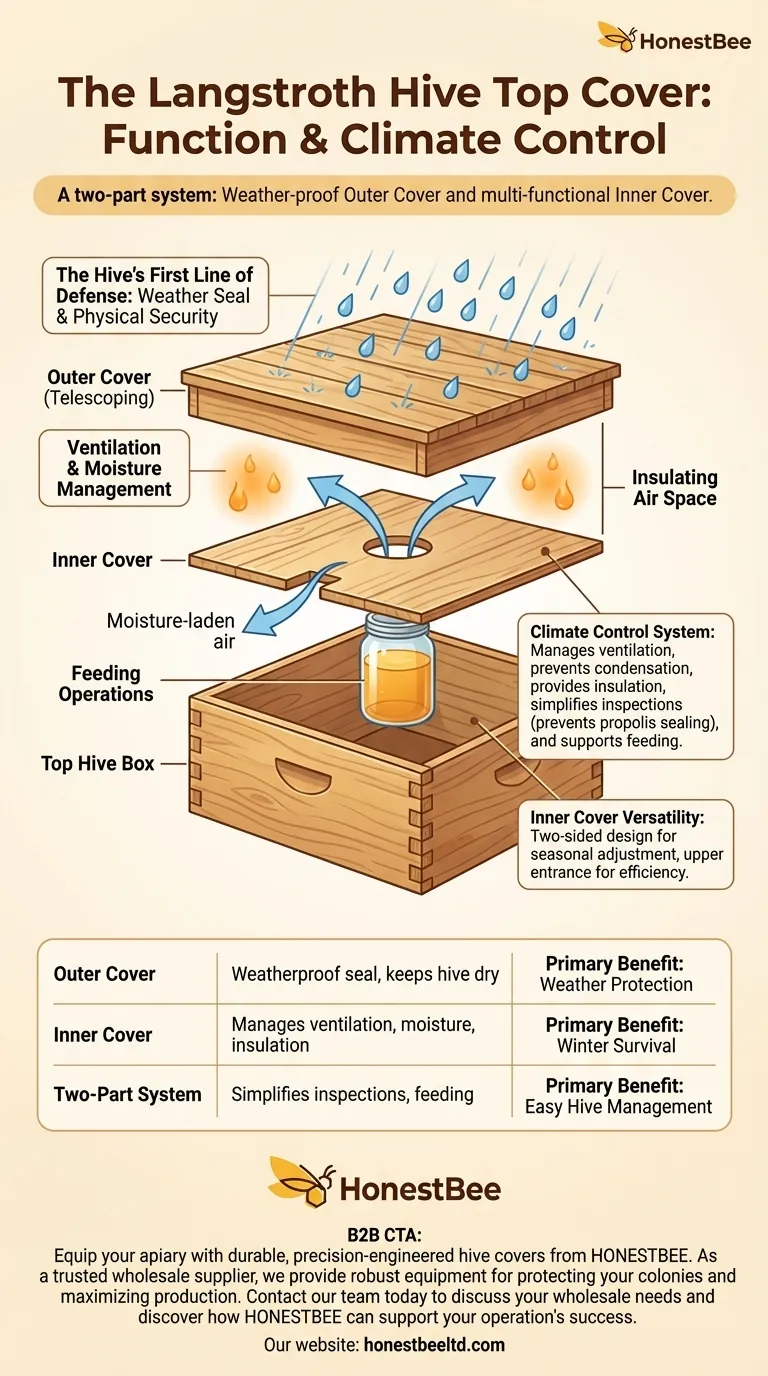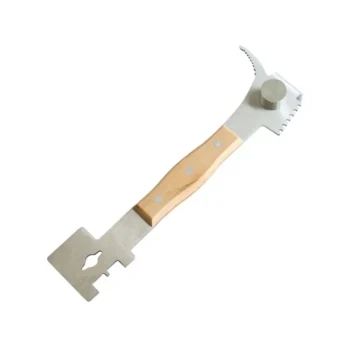In short, the top cover on a Langstroth hive is its roof. Its primary function is to provide the final seal, protecting the colony from rain, snow, and direct sun. This outer layer is a simple but critical shield against the elements, keeping the interior of the hive dry and secure.
The term "top cover" actually refers to a two-part system: a weather-proof outer cover and a multi-functional inner cover. Understanding how these two components work together is essential for managing your hive's internal climate and performing inspections efficiently.

The Outer Cover: The Hive's First Line of Defense
The outer cover is what most people picture when they think of a beehive's lid. Its role is straightforward but non-negotiable for the colony's survival.
Sealing Against Weather
The most common design is the telescoping top cover. This cover overlaps the top hive box and hangs down slightly over the edges.
This design prevents rain from dripping into any small gaps at the top of the hive, ensuring the interior remains completely dry.
Providing Physical Security
As the final layer, the outer cover seals the hive from the outside world. It keeps the colony protected and contained, forming the ultimate barrier between the bees and their external environment.
The Inner Cover: The Hive's Climate Control System
Resting directly on the top hive box, just beneath the outer cover, is the inner cover. This component is far more than just a secondary lid; it is a critical tool for hive management and environmental control.
Managing Moisture and Ventilation
The inner cover is vital for allowing moisture-laden air to exit the hive, which prevents harmful condensation from forming and dripping back onto the bees, especially during winter.
Many inner covers have a small notch on one side. When positioned correctly, this creates an upper entrance and ventilation port for the hive. This improves air circulation and gives bees a secondary access point that won't get blocked by snow or debris.
Creating Insulating Air Space
The space between the inner and outer covers creates a pocket of trapped air. This air provides a significant layer of insulation, protecting the colony from the intense heat of direct summer sun and the biting cold of winter.
Simplifying Hive Inspections
Bees use a sticky resin called propolis to seal every crack inside their hive. Without an inner cover, they would firmly glue the outer cover directly to the top super.
The inner cover provides a smooth, removable barrier that is much easier to detach, preventing damage to the hive and making inspections far less disruptive for both the beekeeper and the bees.
Supporting Feeding Operations
Most inner covers feature a central hole. This hole is perfectly designed for placing a jar or container feeder directly over the bee cluster, making it simple to provide supplemental food when necessary.
Understanding the Nuances
While the system is effective, its configuration depends on the season and your management goals. The versatility of the inner cover is its greatest strength.
The Two-Sided Design
Many inner covers have a shallow side and a deep side. Placing the deep side down in winter can create space for a solid sugar feed, while placing the shallow side down in summer provides optimal ventilation space.
The Upper Entrance
Using the inner cover's notch as a top entrance allows foraging bees to access honey supers directly without traveling through the brood nest. This can reduce congestion at the main entrance and improve the efficiency of honey production.
Making the Right Choice for Your Goal
Properly using the hive's two-part cover system gives you direct control over the colony's environment.
- If your primary focus is weather protection: The telescoping outer cover is non-negotiable for keeping the hive dry and secure.
- If your primary focus is winter survival: The inner cover is your most important tool for managing condensation and providing vital ventilation.
- If your primary focus is easy hive management: The inner cover prevents the outer lid from being glued shut, making inspections faster and less stressful.
Mastering this simple system is a foundational step in becoming an effective and confident beekeeper.
Summary Table:
| Component | Primary Function | Key Benefit |
|---|---|---|
| Outer Cover | Weatherproof seal against rain and sun | Keeps the hive interior completely dry |
| Inner Cover | Manages ventilation and moisture control | Prevents harmful condensation and provides insulation |
| Two-Part System | Simplifies hive inspections and feeding | Prevents propolis sealing; allows for easy feeder placement |
Equip your apiary with durable, precision-engineered hive covers from HONESTBEE.
As a trusted wholesale supplier for commercial apiaries and beekeeping equipment distributors, we provide the robust, reliable equipment essential for protecting your valuable colonies and maximizing honey production. Our Langstroth hive covers are designed for superior weather protection and effective hive management.
Contact our team today to discuss your wholesale needs and discover how HONESTBEE can support your operation's success.
Visual Guide

Related Products
- Telescopic Beehive Outer Cover Lid Roof with Galvanised Sheeting for Langstroth Hive and Beehive Outer Cover
- Long Langstroth Style Horizontal Top Bar Hive for Wholesale
- Langstroth Bee Hives Bee Keeping Box for Beginners Beekeeping
- Professional Insulated Winter Hive Wrap for Beekeeping
- Inner Beehive Cover for Beekeeping Bee Hive Inner Cover
People Also Ask
- What are the features of the peaked roof in Langstroth hives? Superior Weather Protection & Stability
- What is a telescoping outer cover and what are its advantages? Maximize Hive Protection in Harsh Climates
- Can bees enter from both sides of the outer cover? Master Seasonal Hive Management
- What maintenance is recommended for the Langstroth hive roof? Protect Your Hive with Natural Tung Oil
- What is the purpose of a garden hive lid in beekeeping? Essential Protection for Your Colony's Health



















